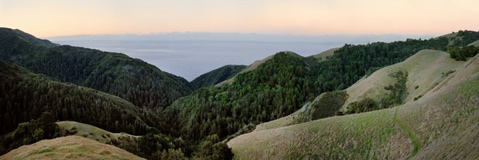Diving into Big Sur’s Big Creek
Profiles in the University of California’s Natural Reserve System

California’s steepest coastal range, the Santa Lucia Mountains, plunges directly into the ocean at Big Sur. Here, Landels-Hill Big Creek Reserve spreads across steep canyons and forested ridgelines an hour’s drive south of Monterey. Composed of largely undisturbed wilderness, this landscape experiences extreme climatic differences between ridgetop and shoreline. Offshore kelp forests and rocky reefs guard the coast, while submarine canyons drop a third of a mile deep directly offshore. The result is a dramatically compressed series of habitats bordered by massive redwoods above and tide pools below.
The reserve spans three watersheds that drain the western flanks of Cone Peak in the Ventana Wilderness. The peak rises 5,155 feet from the ocean in just 3.3 miles, forming one of the steepest coastal gradients in the contiguous United States. The hills rise in a tapestry of mixed hardwood and evergreen trees interspersed with grasslands and dense stands of chaparral. Cutting through the hillsides are cool, moist canyons carved by rushing streams and shaded by groves of coast redwoods and big-leaf maples. Higher slopes are clothed in pines and manzanita, descending through mixed oak and grasslands to coastal scrub. Steelhead trout ply the clean, clear waters of Big Creek to spawn in gravel riffles. Because of its remoteness, Big Creek offers excellent habitat for sensitive species such as the California condor and spotted owl. The adjacent 22.5-square-mile Big Creek State Marine Reserve harbors a multitude of marine life, from rockfish, kelp, and abalone to sea otters and humpback whales.
The abundance at Big Creek attracted native Esselen and Salinan people to the area for more than 6,000 years. Through the late-19th and early-20th centuries, homesteaders drove cattle over the mountains and logged coastal forests. Since 1978, eight conservation-minded families along with The Nature Conservancy and Save the Redwoods League have designated their properties into what is now 8,000 acres of Big Creek Reserve. Thousands of scientists, teachers, and students now use this living laboratory to explore all aspects of natural history observation, research, teaching, and conservation practice.
Living in this landscape can be both physically and psychologically challenging — but for those pursuing interaction with nature, it is rich with rewards. The best part of being the director of Big Creek Reserve is my work with scientists and students. The goal of the reserve is to learn as much as we can about the ecosystems and organisms here. Research feeds the curiosity of the students, which then directs and intensifies the learning process. Everyone benefits from the wildness of Big Creek, which inspires inquiry in both scientists and artists. One of the greatest rewards is witnessing a connection with nature wash over someone’s face and knowing that moment will stay with them for a lifetime. How fortunate we are that certain people had the forethought to provide this opportunity for generations to come.
Portions of this piece are reproduced from “Landels-Hill Big Creek Reserve,” The Environmental Legacy of the UC Natural Reserve System (UC Press).



